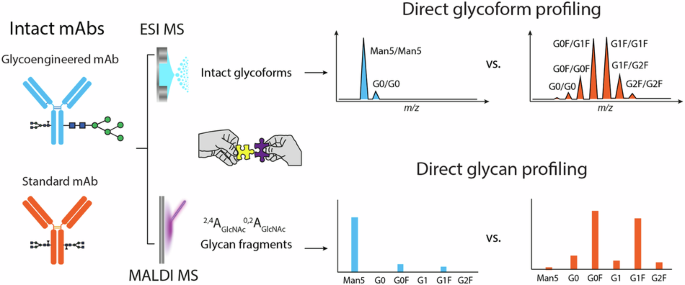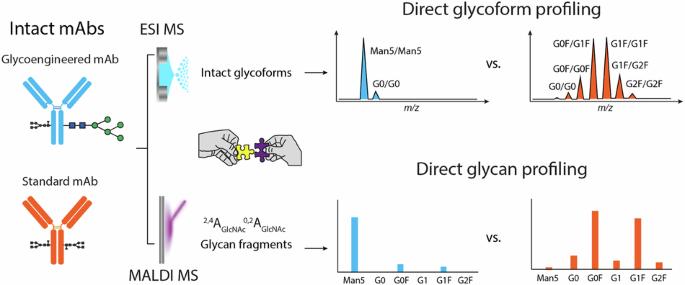Direct glycosylation analysis of intact monoclonal antibodies combining ESI MS of glycoforms and MALDI-in source decay MS of glycan fragments
IF 5.9
2区 化学
Q1 CHEMISTRY, MULTIDISCIPLINARY
引用次数: 0
Abstract
Monoclonal antibody (mAb) glycoengineering has the potential to improve the efficacy of biopharmaceuticals by fine-tuning specific biological properties. Glycosylation analysis is key to monitoring the glycoengineering process. Various mass spectrometry (MS)-based methods are available to characterize mAb glycosylation at different structural levels, but comprehensive analysis is typically time-consuming and costly. Here, we present an approach that combines conventional intact mass measurement of glycoforms by direct infusion ESI-MS with an advanced MALDI-in-source decay FT-ICR MS method for direct analysis of glycans in intact mAbs, without the need for enzymatic release and separation. Using a sodium-doped MALDI matrix, glycans were directly released as ISD fragment ions from the intact mAbs during the ionization process. Measurement of 0,2A fragment signals yielded reproducible glycan profiles that were consistent with conventional methods, yet was achieved with unprecedented speed, providing complementary information to that obtained through intact mass measurement. The methods were applied to standard and glycoengineered trastuzumab and rituximab, allowing rapid glycosylation profiling and structural analysis of glycans by tandem MS of selected ISD fragment ions. This fast approach can facilitate the early-phase development of glycoengineering processes by constraining further in-depth analyses. We envision a broader applicability in studies focused on glycosylation changes in mAbs. Glycoengineering of monoclonal antibodies (mAbs) has the potential to improve the efficacy of biopharmaceuticals, however, monitoring the glycoengineering process by glycosylation analysis often requires a multi-method approach. Here, the authors present a direct glycosylation analysis of intact mAbs by combining conventional ESI-MS of intact glycoforms and MALDI-in-source decay FT-ICR MS of glycan fragments.


结合糖形的 ESI MS 和糖链片段的 MALDI-in source decay MS,对完整单克隆抗体进行直接糖基化分析
单克隆抗体(mAb)糖工程有可能通过微调特定的生物特性来提高生物制药的疗效。糖基化分析是监测糖工程过程的关键。目前有多种基于质谱(MS)的方法来表征不同结构水平的 mAb 糖基化,但全面的分析通常耗时且成本高昂。在这里,我们提出了一种方法,它将传统的直接注入 ESI-MS 测量糖型的完整质量测量方法与先进的 MALDI-in-source decay FT-ICR MS 方法相结合,直接分析完整 mAb 中的聚糖,而无需酶解和分离。使用掺钠 MALDI 基质,在离子化过程中,聚糖作为 ISD 片段离子从完整的 mAbs 中直接释放出来。对 0,2A 片段信号的测量得到了与传统方法一致的可重现的聚糖图谱,而且以前所未有的速度完成,提供了与通过完整质量测量获得的信息互补的信息。这些方法被应用于标准曲妥珠单抗和利妥昔单抗以及经过糖工程化的曲妥珠单抗和利妥昔单抗,从而可以通过对选定的 ISD 片段离子进行串联质谱分析来快速绘制糖基化图谱和分析聚糖的结构。这种快速方法可以限制进一步的深入分析,从而促进糖工程过程的早期开发。我们设想这种方法将更广泛地应用于以 mAbs 糖基化变化为重点的研究中。
本文章由计算机程序翻译,如有差异,请以英文原文为准。
求助全文
约1分钟内获得全文
求助全文
来源期刊

Communications Chemistry
Chemistry-General Chemistry
CiteScore
7.70
自引率
1.70%
发文量
146
审稿时长
13 weeks
期刊介绍:
Communications Chemistry is an open access journal from Nature Research publishing high-quality research, reviews and commentary in all areas of the chemical sciences. Research papers published by the journal represent significant advances bringing new chemical insight to a specialized area of research. We also aim to provide a community forum for issues of importance to all chemists, regardless of sub-discipline.
 求助内容:
求助内容: 应助结果提醒方式:
应助结果提醒方式:


